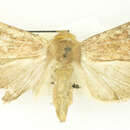Conservation Status
provided by University of Alberta Museums
Widespread and common.
- license
- cc-by-nc
- copyright
- University of Alberta Museums
Cyclicity
provided by University of Alberta Museums
Adults fly in Alberta in July and August.
- license
- cc-by-nc
- copyright
- University of Alberta Museums
Distribution
provided by University of Alberta Museums
Newfoundland west to British Colimbia, north to the Yukon and Northwest Territories and south at least to Colorado. In Alberta it has been colllected thoughout most of southern two-thirds of the province.
- license
- cc-by-nc
- copyright
- University of Alberta Museums
General Description
provided by University of Alberta Museums
"A medium-sized (3.4-3.6 cm wingspan) rusty-brown or yellow-brown, or ocassionaly pink moth with few markings, the most prominent being the dark, somewhat smeared and elongated reniform spot. The postmedian and subterminal lines are usually visible as faint thin dark lines, edged with paler scales. The hindwings are like the forewings in color, but paler on the basal half and darker on the distal half, with an indistinct discal mark. Male antennae setose; female simple. Sexes similar. Paradiarsia littoralis is similar but smaller and has dark grey or black hindwings and bipectinate male antennae.
Until recently treated as A. indela or A. popofensis, which are now treated as subspecies of A. inficita (Troubridge and Lafontaine, in press). Older literature (i.e. Bowman, 1951) places inficita in the genus Agroperina
"
- license
- cc-by-nc
- copyright
- University of Alberta Museums
Habitat
provided by University of Alberta Museums
Mesic meadows and woodland edges.
- license
- cc-by-nc
- copyright
- University of Alberta Museums
Life Cycle
provided by University of Alberta Museums
"Poorly known. A. inficita is sometimes common nectaring at flowers at dusk, and also comes to light. There is a single anuual brood. The larvae are apparently unknown.
Although found in the foothills at Calgary and west of Bragg Creek, it has not yet been taken elsewhere in the foothills or mountain meadows in AB. The populations of popofensis in western Canada and the adjacent states have been treated as both ssp. lineosa and ssp. indela. Cook (1930) stated these were merely colour forms, although Hodges et al (1983) still treat these names as valid subspecies. Until recently this species was placed in the genus Agroperina, but Poole (1989) synonomized Agroperina and Apamea."
- license
- cc-by-nc
- copyright
- University of Alberta Museums
Trophic Strategy
provided by University of Alberta Museums
Unknown. Related species oviposit on grass inflorescences, and use grasses as the host.
- license
- cc-by-nc
- copyright
- University of Alberta Museums
Apamea inficita
provided by wikipedia EN
- license
- cc-by-sa-3.0
- copyright
- Wikipedia authors and editors
Apamea inficita: Brief Summary
provided by wikipedia EN
Apamea inficita, the lined Quaker is a moth of the family Noctuidae. The species was first described by Francis Walker in 1857. It is native to North America, where it can be found from Newfoundland west to British Columbia, north to the Yukon and the Northwest Territories, and south to Colorado.
The wingspan is 34–36 mm. The moth flies from July to August depending on the location.
- license
- cc-by-sa-3.0
- copyright
- Wikipedia authors and editors

